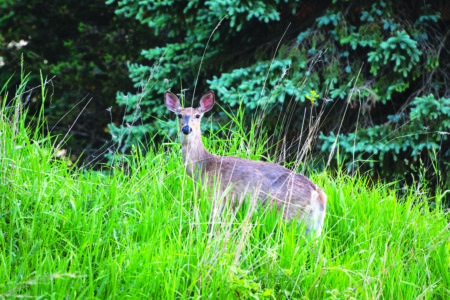Cancel jumping worms: wrangling those wrigglers

Photo by Tara L. Bal
Shown, at top, the soil surface looks like granular coffee grounds from jumping worm activity. At bottom, shown is a jumping worm with white clitellum or the band or ring near the head.
Earthworms. We are all familiar with these wiggly organisms and their association with healthy gardens. But did you know that earthworms are not native to the UP? In fact, there are no native earthworms in any places that were covered in glaciers during the last ice age. As the glaciers made their way south, they shoveled out all the soil in their path. Earthworms, which live in the soil, were pushed out too. Because they move slowly on their own, the species that used to be here haven’t made their way back!
You might be wondering, “If the earthworms were pushed out, then how come I see them when I dig in my garden?” That’s because new species of earthworms were introduced from Europe during the settlement of the Upper Peninsula! The earthworms we see today could be descendents of those literally brought over on ships from Europe, either in soil used for ballast or in the soil of potted plants. Today, additional introductions of earthworms continue and they are spread far and wide by human activity such as gardening, improper disposal of fishing bait, off-roading, or building new roads. According to research conducted by Frelich and in 2019 (https://doi.org/10.1002/fee.2099), these introduced earthworms are causing a lot of trouble for forests here in the UP, because our forests have been growing for the last 10,000 years without the activity of these industrious ecosystem engineers. They cause changes in the soil that impact the whole food chain, because the soil is the foundation on which forest ecosystems are built. You can still find places in the UP without any earthworms, though these are getting fewer.
Of increasing concern is that there is a relatively new kind of earthworm, the jumping worm, first seen in the U.S. in 2013 in Wisconsin (our close neighbor!). Since then, they have been found in 34 states, including Michigan, although no sightings have been reported in the UP as of yet. These jumping worms, also called Alabama jumpers, crazy worms, or snake worms, are a few types of species different from the earthworms you are used to seeing in your garden. Jumping worms have a flat, smooth, gray or white clitellum (the thing that looks like a collar or Band-aid (see photo inset), and they excrete a thick, yellow mucus when handled. They also vigorously jump around and thrash when handled and wriggle like snakes, hence the name. Their impact on the soil has been described as like regular earthworms on steroids. They act much faster, eating any mulch or litter, reducing nutrients and life in the soil, and causing it to dry out very quickly and increase erosion. They leave the soil looking like dry, clumpy coffee grounds (see photo inset), which isn’t good for forests or even many plants in your garden!
The good news is that there are steps we can take to prevent jumping worms from spreading to the UP! They are moved around in the same ways as other earthworms, which is primarily by human activity. Some ways we can help include:
• do not dump fishing bait out in water or the ground,
• clean off boots between hiking trips,
• check mulch and potted plants for hitch-hiking earthworm, and
• do not move soil or mulch around from place to place without inspecting it first.
Although there are some methods for eradicating them once introduced, such as heat-treating soil or complete removal of topsoil, this is very expensive and only works on small areas (like yard lots, or raised gardens along houses, etc.). These methods can also cause collateral damage on native soil-dwelling organisms that we want to keep around, like fireflies and some pollinators!
So, keep an eye out for evidence of earthworm activity in your yard (soil that looks like coffee grounds), and if you suspect you have jumping worms, you can report it to MISIN (https://www.misin.msu.edu/report/misin/?project=misin) or contact KISMA (KISMA.up@gmail.com) for assistance!
For more information:
Invasive Species: Jumping Worms – State of Michigan. https://www.michigan.gov/invasives/id-report/worms/jumping-worms
MISIN: Midwest Invasive Species Network. Jumping Worm (Amynthas agrestis) http://www.misin.msu.edu/facts/detail/?project=misin&id=322&cname=Jumping%20worm
Shelby Lane-Clark, Master of Science in Forest Ecology and Management Student, College of Forest Resources and Environmental Science, Michigan Technological University, can be reached at snlanecl@mtu.edu. Tara L. Bal, Assistant Professor, College of Forest Resources and Environmental Science, Michigan Technological University, can be reached at tlbal@mtu.edu.






